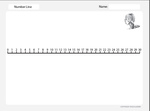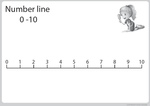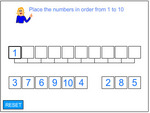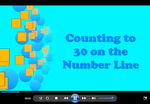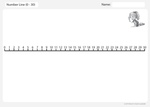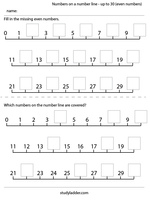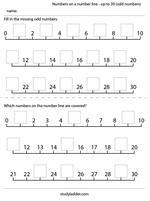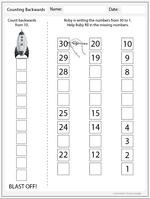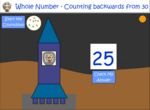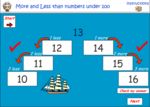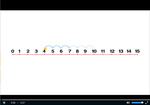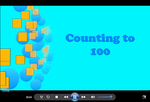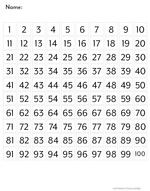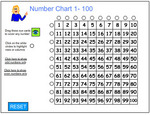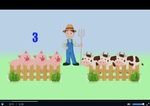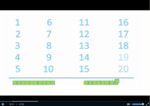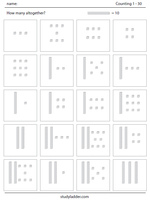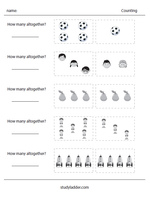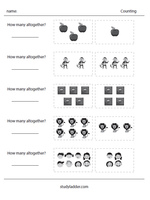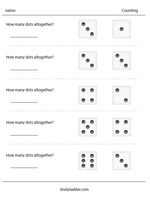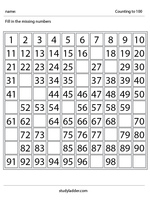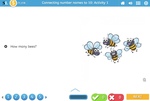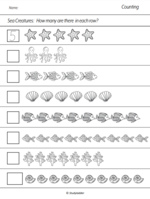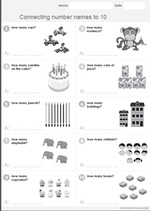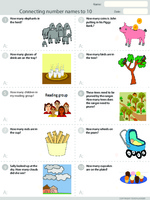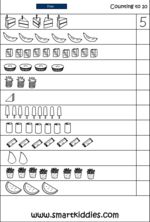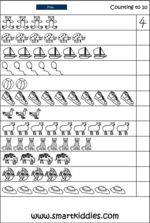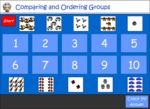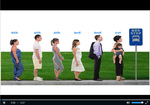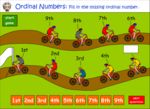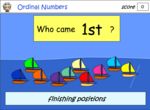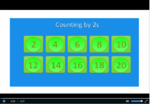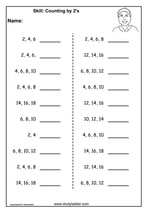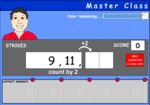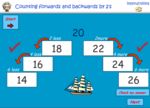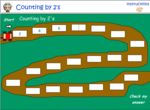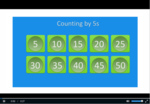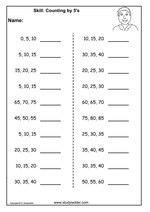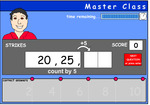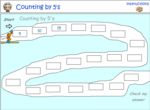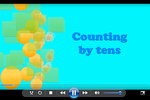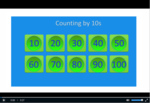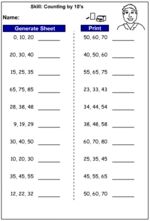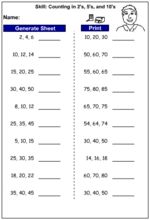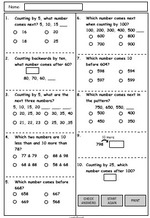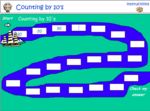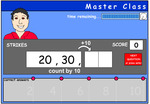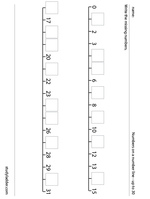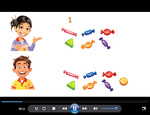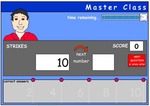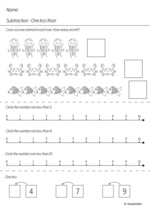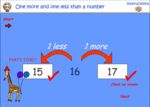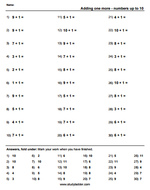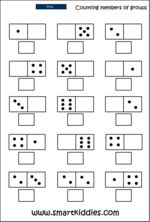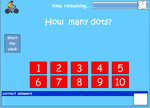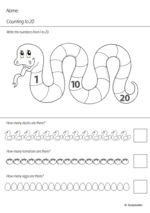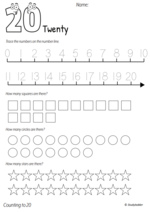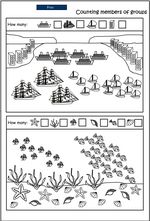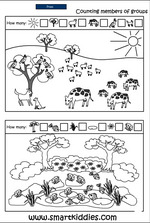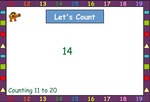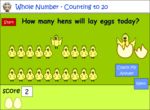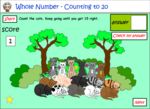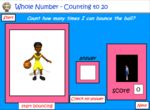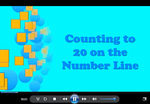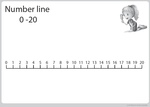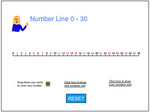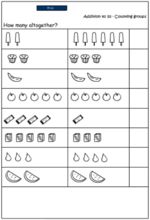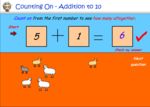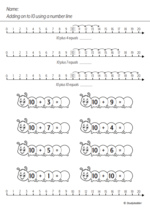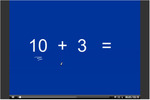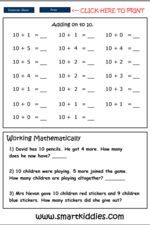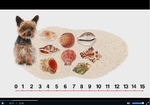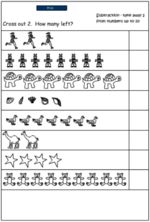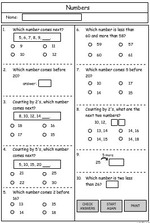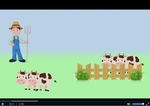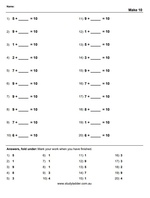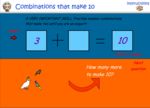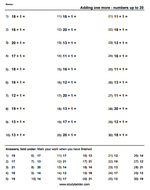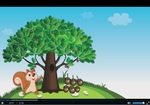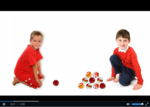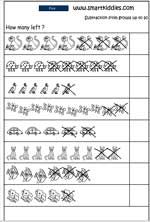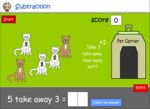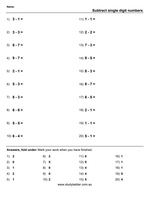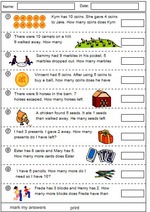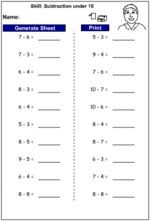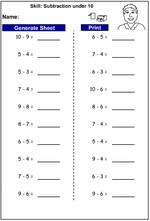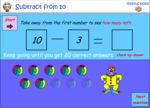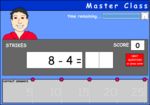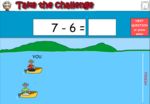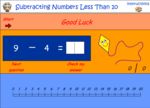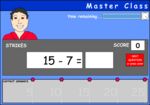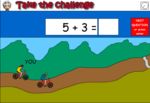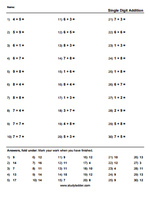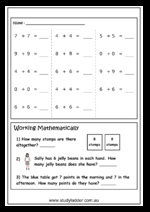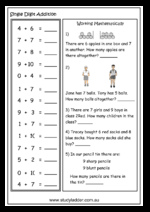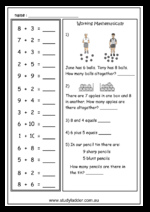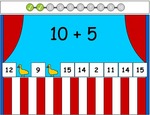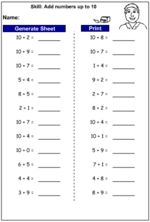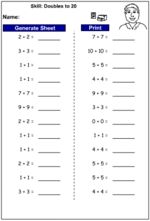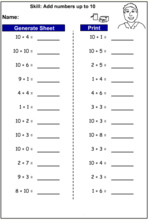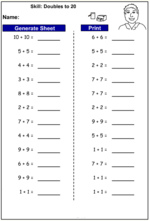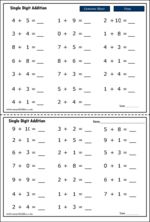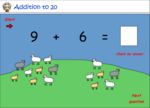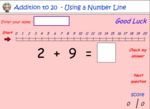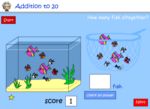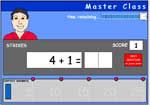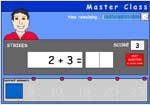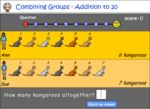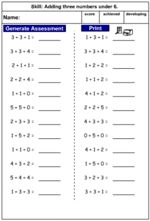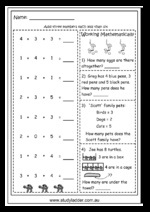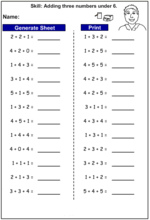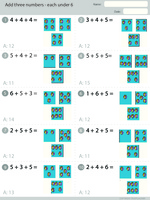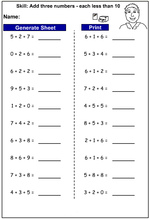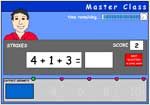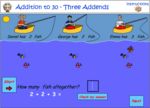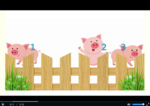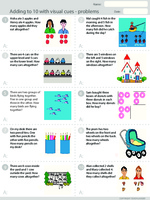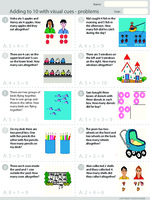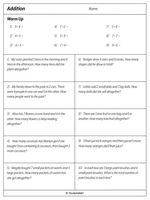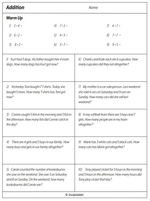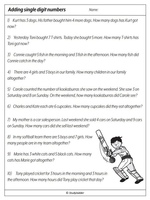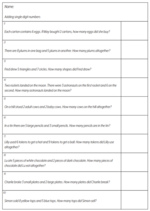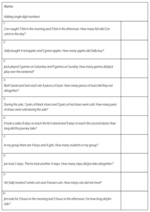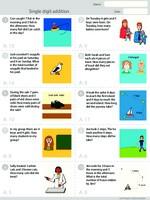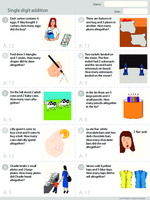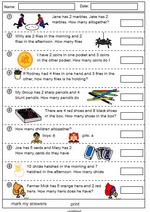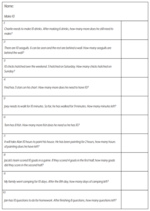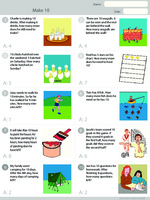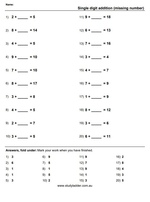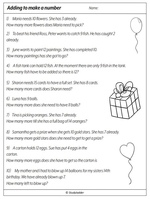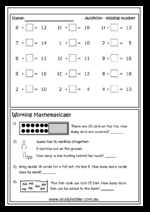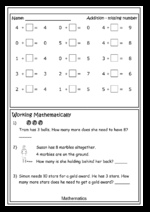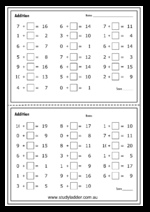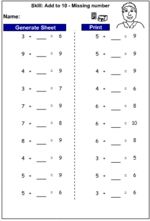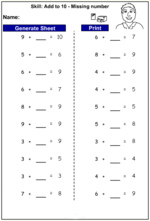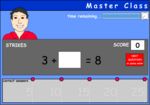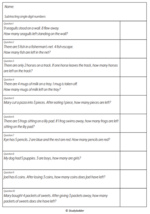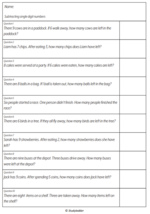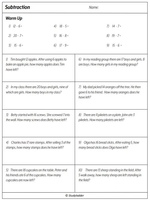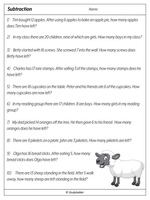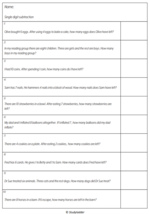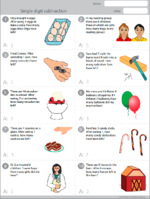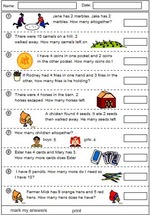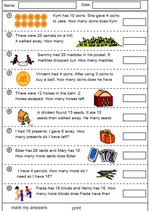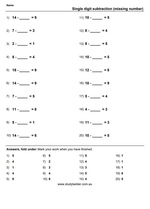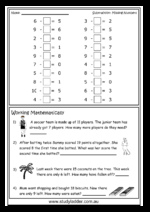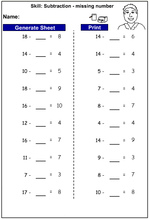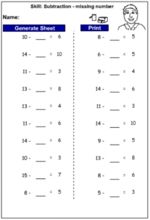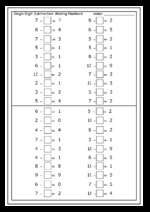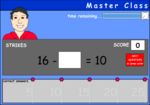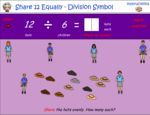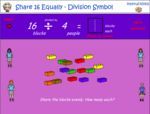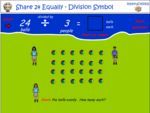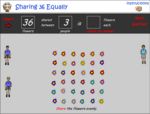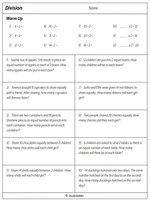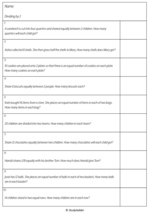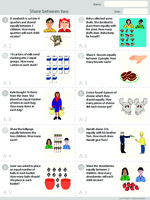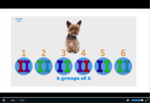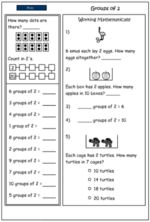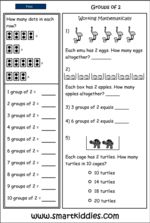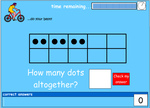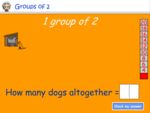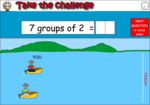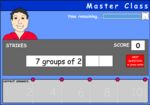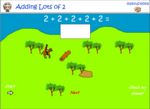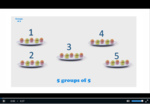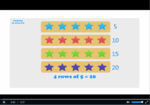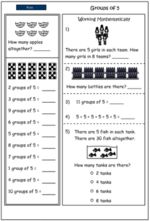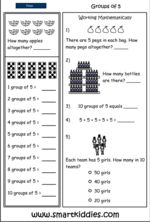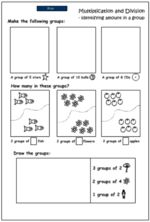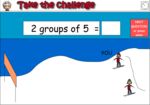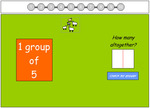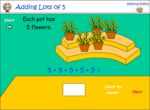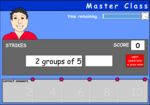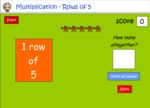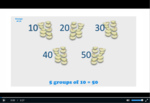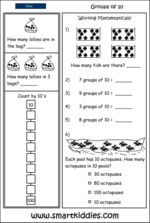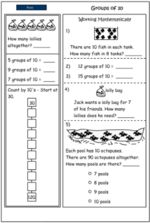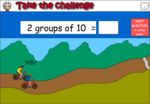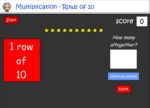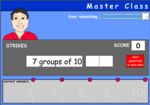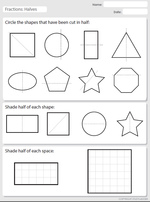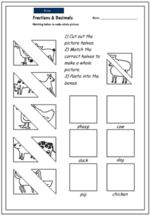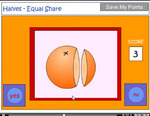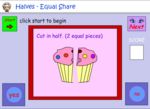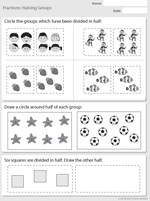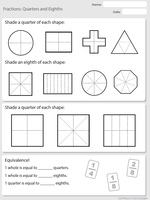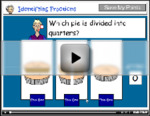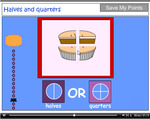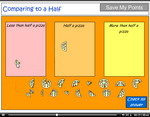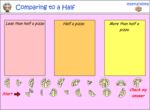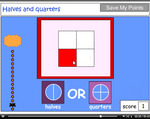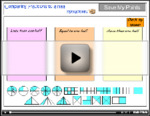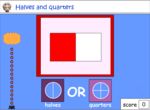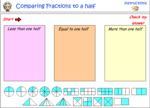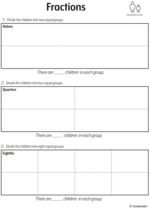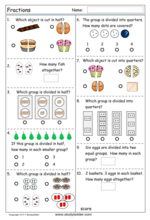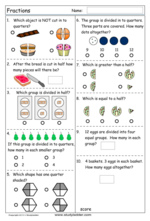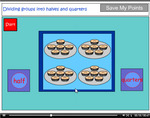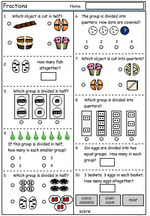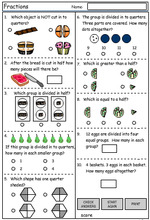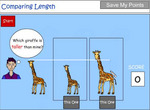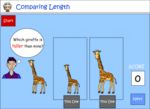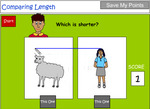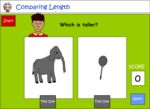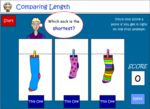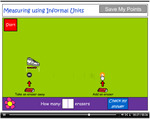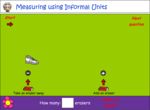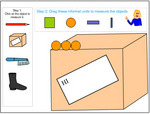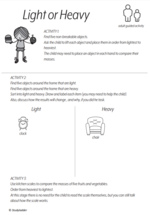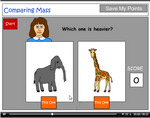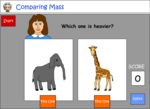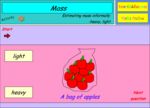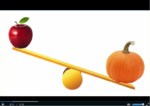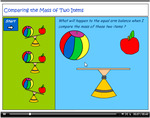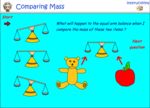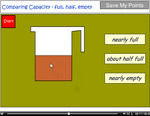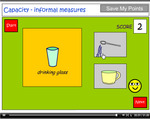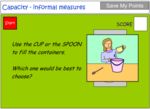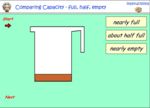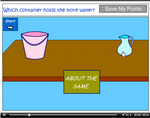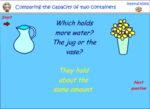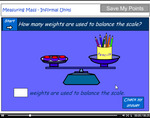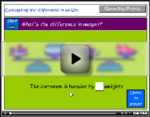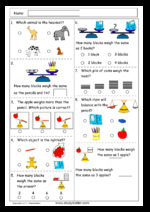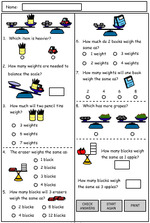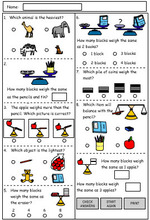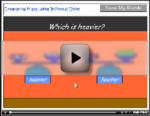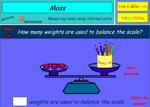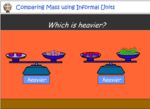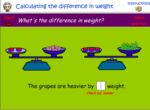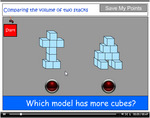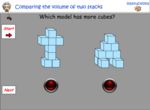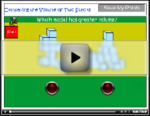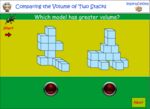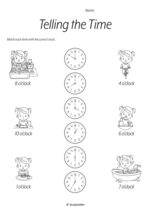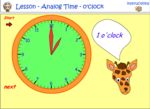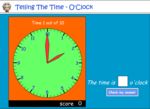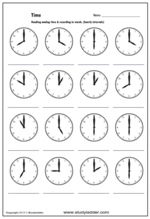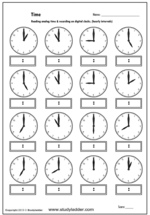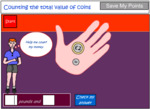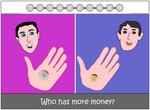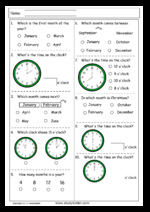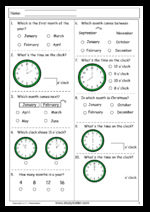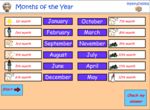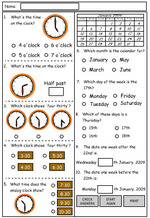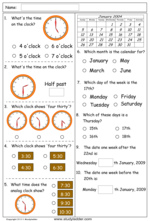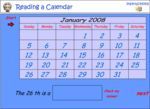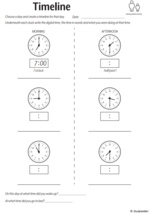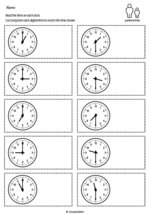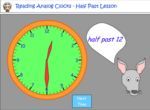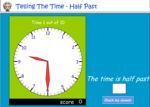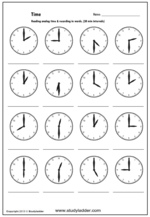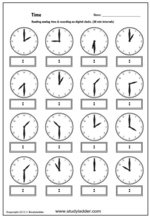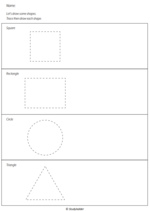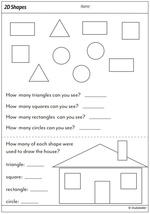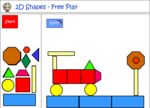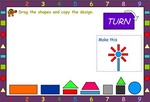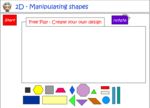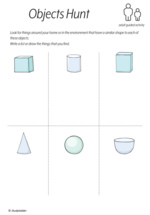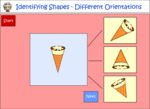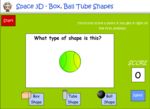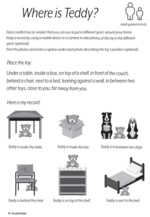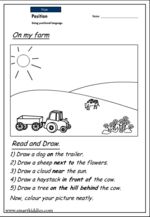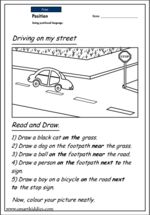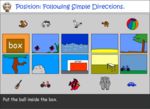Mathematics – United Kingdom – National Curriculum
Year 1 programme of study
KS1.Y1.N.NPV – Number - number and place value
Pupils should be taught to:
KS1.Y1.N.NPV.1 – Count to and across 100, forwards and backwards, beginning with 0 or 1, or from any given number
-
9 learning outcomes – click to view
Samples: Number line. Counting to ten on the number line. Counting to 30 on a number line. Counting backwards.
-
Counting to 10 using a number line
- Activities: 6 course, 2 extra
-
-
- Counting to ten on the number line
- Tutorial
-
-
-
- Counting to ten on the number line
- Tutorial
-
-
-
- Counting on the number line to 10
- Practice
-
-
-
- Number line to 10 (missing numbers)
- Practice
-
-
-
- Counting to 10 on the Number Line
- Tutorial
-
Extra activities
-
-
- Number line (0-10)
- Printable
-
-
-

- Ordering Numbers 1 - 10
- Whiteboard
-
-
Counting to 30 on a number line
- Activities: 5 course, 4 extra
-
-
- Counting to 30 on a number line
- Tutorial
-
-
-
- Numbers to 30 (number line)
- Practice
-
-
-
- Numbers to 30 (number line)
- Practice
-
-
-
- Numbers to 30 (number line)
- Tutorial
-
Extra activities
-
-
- Number line (0-30)
- Printable
-
-
-
- Numbers to 30 (number line)
- Printable
-
-
-
- Numbers to 30 (number line)
- Printable
-
-
-

- Let's Count Together 21-30
- Practice
-
-
Counting backwards from 30
- Activities: 5 course, 4 extra
-
-
- Counting backwards
- Tutorial
-
-
-
- Counting down from 30
- Tutorial
-
-
-
- Counting backwards
- Practice
-
Extra activities
-
-
- Counting backwards
- Printable
-
-
-

- Counting backwards from 30
- Practice
-
-
-
- Counting backwards from 30
- Tutorial
-
-
-

- Count forwards and backwards by 1
- Practice
-
-
Counting backwards from ten
- Activities: 5 course, 2 extra
-
-
- Counting forwards and backwards by 1
- Tutorial
-
-
-
- Counting backwards from 10
- Practice
-
-
-
- Counting backwards on a number line
- Practice
-
Extra activities
-
Counting to 100 using a hundreds chart
- Activities: 6 course, 2 extra
-
-
- Counting to 100
- Tutorial
-
-
-
- Missing numbers
- Tutorial
-
-
-
- Hundreds chart 1-30
- Practice
-
-
-
- Hundreds chart 31-60
- Practice
-
-
-
- Hundreds chart 61-100
- Practice
-
-
-
- Hundred's Chart Count
- Tutorial
-
Extra activities
-
-
- Hundred's Chart
- Printable
-
-
-

- Number Chart 1 - 100
- Whiteboard
-
-
Counting: 1-30 (Skill 1)
- Activities: 12 course, 13 extra
-
-
- Counting to ten
- Tutorial
-
-
-
- Counting to 20
- Tutorial
-
-
-
- Counting to 30
- Tutorial
-
-
-
- Counting animals
- Tutorial
-
-
-
- Counting to 20 using counters
- Tutorial
-
-
-
- Counting to 30 on the Number Line
- Tutorial
-
-
-
- Counting 1-10
- Practice
-
-
-
- Counting 1-10
- Practice
-
-
-
- Counting 11-20
- Practice
-
-
-
- Counting 21-30
- Practice
-
-
-
- Counting 1 - 30
- Printable
-
-
-
- Counting to 30
- Assessment Practice
-
Extra activities
-
-
- Counting 1
- Printable
-
-
-
- Counting 2
- Printable
-
-
-
- Counting problem solving
- Practice
-
-
-
- Counting
- Practice Printable
-
-
-

- 2: Counting
- Printable
-
-
-
- Counting
- Practice Printable
-
-
-
- Counting to 10
- Assessment Practice
-
-
-
- Counting to 10
- Printable
-
-
-
- white 2 sheet 2
- Printable
-
-
-
- white 2 sheet 3
- Printable
-
-
-
- white 2 sheet 4
- Printable
-
-
-
- white 2 sheet 5
- Printable
-
-
-
- Counting 3
- Printable
-
-
Counting to 100 (Skill 3)
- Activities: 6 course, 5 extra
-
-
- Counting to 100
- Tutorial
-
-
-
- Hundred's Chart Count
- Tutorial
-
-
-
- Counting to 100 - Activity 2
- Practice
-
-
-
- Counting to 100 - Activity 3
- Practice
-
-
-
- Counting to 100
- Assessment Practice
-
Extra activities
-
-
- Counting to 100
- Printable
-
-
-
- Numbers On A Number Line To Thirty (Odd Numbers)
- Practice Printable
-
-
-
- white 3 sheet 1
- Printable
-
-
9 learning outcomes – click to view
KS1.Y1.N.NPV.2 – Count, read and write numbers to 100 in numerals; count in multiples of 2s, 5s and 10s
-
7 learning outcomes – click to view
Samples: Counting on the farm. Counting to 100. Ordinal numbers. Counting on number line (by 2's).
-
Counting to 10
- Activities: 11 course, 7 extra
-
-
- Counting on the farm
- Tutorial
-
-
-
- How many circles
- Practice
-
-
-
- Counting objects (to 10)
- Practice
-
-
-
- Counting objects (to 10)
- Practice
-
-
-
- Counting objects to 10 (sheep)
- Practice
-
-
-
- Counting objects to 10
- Practice
-
-
-
- Counting objects to 10
- Practice
-
-
-
- Counting to 10
- Printable
-
-
-
- Counting objects (to 10)
- Tutorial
-
Extra activities
-
-
- Numbers 1 - 10 (posters)
- Printable
-
-
-
- Counting to 10
- Printable
-
-
-
- Counting to 10
- Printable
-
-
-
- Counting to 10
- Printable
-
-
-
- Counting to 10
- Printable
-
-
-

- Counting to 10
- Practice
-
-
-

- Ordering groups of objects to 10
- Practice
-
-
Counting to 100 using a hundreds chart
- Activities: 6 course, 2 extra
-
-
- Counting to 100
- Tutorial
-
-
-
- Missing numbers
- Tutorial
-
-
-
- Hundreds chart 1-30
- Practice
-
-
-
- Hundreds chart 31-60
- Practice
-
-
-
- Hundreds chart 61-100
- Practice
-
-
-
- Hundred's Chart Count
- Tutorial
-
Extra activities
-
-
- Hundred's Chart
- Printable
-
-
-

- Number Chart 1 - 100
- Whiteboard
-
-
Ordinal numbers
- Activities: 4 course, 2 extra
-
-
- Ordinal numbers
- Tutorial
-
-
-
- Ordinal numbers
- Practice
-
-
-
- Ordinal Numbers
- Tutorial
-
-
-
- Ordinal numbers
- Practice
-
Extra activities
-
-

- Ordinal numbers
- Practice
-
-
-

- Ordinal numbers
- Practice
-
-
Counting on by two on a number line
- Activities: 7 course, 5 extra
-
-
- Counting on number line (by 2's)
- Tutorial
-
-
-
- Counting by 2
- Practice
-
-
-
- Counting by 2
- Practice
-
-
-
- Counting by 2
- Practice
-
-
-
- Counting by 2
- Tutorial
-
-
-
- Counting by 2
- Tutorial
-
-
-
- Counting by Two - Faster
- Tutorial
-
Extra activities
-
-
- Counting by 2
- Printable
-
-
-
- Counting by 2
- Tutorial
-
-
-

- Counting by 2
- Assessment
-
-
-

- Count on by 2 the next three numbers
- Practice
-
-
-

- Count by lots of 2
- Practice
-
-
Counting on by five on a number line
- Activities: 6 course, 3 extra
-
-
- Counting on number line (by 5's)
- Tutorial
-
-
-
- Counting by 5
- Tutorial
-
-
-
- Counting by 5
- Practice
-
-
-
- Counting by 5
- Practice
-
-
-
- Counting by 5
- Practice
-
-
-
- Counting by 5
- Tutorial
-
Extra activities
-
-
- Counting by 5
- Printable
-
-
-

- Counting by 5
- Assessment
-
-
-

- Count by lots of 5
- Practice
-
-
Counting on by ten on a number line
- Activities: 6 course, 5 extra
-
-
- Counting on number line (by 10's)
- Tutorial
-
-
-
- Counting by 10
- Practice
-
-
-
- Counting by 10
- Practice
-
-
-
- Counting by 10
- Practice
-
-
-
- Counting by 10
- Tutorial
-
-
-
- Counting by 10
- Tutorial
-
Extra activities
-
-
- Counting by 10
- Printable
-
-
-
- Counting by 10
- Printable
-
-
-

- Numbers Problem Solving
- Assessment
-
-
-

- Count by lots of 10
- Practice
-
-
-

- Counting by 10
- Assessment
-
-
Numbers to 30 (Skill 2)
- Activities: 5 course, 5 extra
-
-
- Counting to 30 on a number line
- Tutorial
-
-
-
- Counting to 30 on the Number Line
- Tutorial
-
-
-
- Numbers on a number line: 1 - 30
- Assessment Practice
-
Extra activities
-
-
- Numbers on the number line: 1 - 30
- Printable
-
-
-
- Numbers On A Number Line, Up To Thirty, Even Numbers
- Practice Printable
-
-
-
7 learning outcomes – click to view
KS1.Y1.N.NPV.3 – Given a number, identify 1 more and 1 less
-
5 learning outcomes – click to view
Samples: Counting ones. Ordinal numbers. One and two more than. One and two less than. One and two more than. Test.
-
Ordinal numbers
- Activities: 4 course, 2 extra
-
-
- Ordinal numbers
- Tutorial
-
-
-
- Ordinal numbers
- Practice
-
-
-
- Ordinal Numbers
- Tutorial
-
-
-
- Ordinal numbers
- Practice
-
Extra activities
-
-

- Ordinal numbers
- Practice
-
-
-

- Ordinal numbers
- Practice
-
-
One more than
- Activities: 6 course, 3 extra
-
-
- One and two more than
- Tutorial
-
-
-
- One more than
- Practice
-
-
-
- One more than - number line
- Practice
-
-
-
- One more than - problem solving
- Practice
-
-
-
- One More Than
- Tutorial
-
-
-
- Kevin Captivate Test
- Practice
-
Extra activities
-
-
- TEST
- Practice
-
-
-
- ONE MINUTE CHALLENGE - Adding 1
- Challenge
-
-
-

- Next number - numbers up to 20
- Assessment
-
-
One less than
- Activities: 3 course, 2 extra
-
-
- One and two less than
- Tutorial
-
-
-
- One less
- Practice
-
-
-
- One Less Than
- Tutorial
-
Extra activities
-
-
- One less than
- Printable
-
-
Adding 1 more - numbers to 10 (Skill 4)
- Activities: 6 course, 7 extra
-
-
- One and two more than
- Tutorial
-
-
-
- One More Than
- Tutorial
-
-
-
- Adding one more - numbers up to 10
- Practice
-
-
-
- Adding one more - numbers up to 10
- Practice
-
-
-
- Adding one more - numbers up to 10
- Practice
-
-
-
- Adding one more - numbers up to 10
- Assessment Practice
-
Extra activities
-
-
- Adding one more - numbers up to 10
- Printable
-
-
-

- 5: Adding One More Up To 10
- Printable
-
-
-
- white 5 sheet 1
- Printable
-
-
-
- white 5 sheet 2
- Printable
-
-
-
- white 5 sheet 3
- Printable
-
-
-
- white 5 sheet 4
- Printable
-
-
-
- white 5 sheet 5
- Printable
-
-
5 learning outcomes – click to view
KS1.Y1.N.NPV.4 – Identify and represent numbers using objects and pictorial representations including the number line, and use the language of: equal to, more than, less than (fewer), most, least
-
4 learning outcomes – click to view
Samples: Subitising - ten frame. Subatising - fingers. Subitising - Matching quantities. Comparing groups (least).
-
Subitising - ten frame
- Activities: 2 course, 2 extra
-
-
- Subitising - ten frame
- Practice
-
-
-
- Subitising - ten frame
- Practice
-
Extra activities
-
-
- Recognizing a dot pattern
- Printable
-
-
-

- Timed number
- Practice
-
-
Subitising - objects
- Activities: 4 course, 3 extra
-
-
- Subatising - fingers
- Tutorial
-
-
-
- Subitising - objects
- Practice
-
-
-
- Subitising - objects
- Practice
-
-
-
- Subitising - objects
- Practice
-
Extra activities
-
-
- Subitising - objects
- Printable
-
-
-
- Subitising - objects
- Printable
-
-
Subitising - Matching quantities
- Activities: 2 course, 1 extra
-
-
- Subitising - Matching quantities
- Practice
-
-
-
- Subitising - Matching quantities
- Practice
-
Extra activities
-
-
- Matching pairs of quantities
- Practice
-
-
Comparing groups and numbers
- Activities: 4 course, 0 extra
-
-
- Comparing groups (least)
- Practice
-
-
-
- Comparing groups (most)
- Practice
-
-
-
- Comparing groups - to 10
- Practice
-
-
-
- Comparing written numbers
- Practice
-
-
-
4 learning outcomes – click to view
KS1.Y1.N.NPV.5 – Read and write numbers from 1 to 20 in numerals and words
-
3 learning outcomes – click to view
Samples: Comparing groups (least). Counting to 20. Counting from 10 to 20 on a number line. Comparing groups (most).
-
Comparing groups and numbers
- Activities: 4 course, 0 extra
-
-
- Comparing groups (least)
- Practice
-
-
-
- Comparing groups (most)
- Practice
-
-
-
- Comparing groups - to 10
- Practice
-
-
-
- Comparing written numbers
- Practice
-
-
Counting to 20
- Activities: 7 course, 7 extra
-
-
- Counting to 20
- Tutorial
-
-
-
- Counting to 20
- Tutorial
-
-
-
- Counting 20 objects (from 10)
- Practice
-
-
-
- Counting to twenty using counters
- Practice
-
-
-
- Counting to 20
- Printable
-
-
-
- How many to 20
- Printable
-
-
-
- Counting to 20 using counters
- Tutorial
-
Extra activities
-
-
- Counting to 10 and 20 - part 2
- Printable
-
-
-
- Counting to 10 and 20 - part 1
- Printable
-
-
-

- Let's count Together 11-20
- Practice
-
-
-

- Count to 20 - chooks
- Practice
-
-
-

- Count to 20 - cats
- Practice
-
-
-

- Count to 20 - sport
- Practice
-
-
Counting to 20 on a number Line
- Activities: 4 course, 2 extra
-
-
- Numbers to 20 (number line)
- Practice
-
-
-
- Counting on the Number Line to 20
- Tutorial
-
Extra activities
-
-
- Number line (0-20)
- Printable
-
-
-

- Number Line 1 - 30
- Whiteboard
-
-
-
3 learning outcomes – click to view
KS1.Y1.N.AS – Number - addition and subtraction
Pupils should be taught to:
KS1.Y1.N.AS.1 – Read, write and interpret mathematical statements involving addition (+), subtraction (-) and equals (=) signs
-
10 learning outcomes – click to view
Samples: Adding by counting (printable). Adding on to 10 by counting. Count on and back by 2. Subtracting 2.
-
Adding to ten using visual cues
- Activities: 0 course, 3 extra
Extra activities
-
-
- Adding by counting (printable)
- Printable
-
-
-

- Add on to 5
- Practice
-
-
-

- Addition of numbers less than 5
- Practice
-
-
Adding-on to 10
- Activities: 7 course, 4 extra
-
-
- Adding on to 10 by counting
- Tutorial
-
-
-
- Adding on to ten
- Tutorial
-
-
-
- Adding on to 10 by counting
- Practice
-
-
-
- Number Lines - adding on to 10
- Practice
-
-
-
- Adding on to 10
- Practice
-
-
-
- Adding on to 10 (problem solving)
- Practice
-
Extra activities
-
-
- Adding on to 10 using a number line
- Printable
-
-
-
- Adding on to 10 with visual cues.
- Practice
-
-
-
- Add on to 10
- Tutorial
-
-
-
- Add on to 10
- Printable
-
-
Two less than
- Activities: 2 course, 3 extra
-
-
- Count on and back by 2
- Tutorial
-
-
-
- Two less than
- Practice
-
Extra activities
-
-
- Subtract 2 from numbers under 10
- Printable
-
-
-

- Numbers
- Assessment
-
-
Subtracting 2
- Activities: 3 course, 0 extra
-
-
- Subtracting 2
- Tutorial
-
-
-
- Subtracting 2
- Practice
-
-
-
- Subtracting 2 (problem solving)
- Practice
-
-
One more than
- Activities: 6 course, 3 extra
-
-
- One and two more than
- Tutorial
-
-
-
- One more than
- Practice
-
-
-
- One more than - number line
- Practice
-
-
-
- One more than - problem solving
- Practice
-
-
-
- One More Than
- Tutorial
-
-
-
- Kevin Captivate Test
- Practice
-
Extra activities
-
-
- TEST
- Practice
-
-
-
- ONE MINUTE CHALLENGE - Adding 1
- Challenge
-
-
-

- Next number - numbers up to 20
- Assessment
-
-
One less than
- Activities: 3 course, 2 extra
-
-
- One and two less than
- Tutorial
-
-
-
- One less
- Practice
-
-
-
- One Less Than
- Tutorial
-
Extra activities
-
-
- One less than
- Printable
-
-
Balancing equations - Equivalent number sentences
- Activities: 3 course, 0 extra
-
-
- Balancing equations - addition
- Practice
-
-
-
- Balancing equations - subtraction
- Practice
-
-
-
- Balancing equations - addition
- Practice
-
-
Make 10.
- Activities: 5 course, 4 extra
-
-
- Make 10
- Tutorial
-
-
-
- Make 10
- Practice
-
-
-
- Make 10
- Practice
-
-
-
- Make 10 (20 questions)
- Practice
-
-
-
- Make 10 - Using a number line
- Practice
-
Extra activities
-
-
- Make 10
- Tutorial
-
-
-
- Make 10
- Printable
-
-
-
- Make 10 - Visual cues
- Practice
-
-
-

- Combination to 10
- Practice
-
-
Adding 1 more - numbers to 20 (Skill 5)
- Activities: 5 course, 7 extra
-
-
- One More Than
- Tutorial
-
-
-
- Adding one more - numbers up to 20
- Practice
-
-
-
- Adding one more - numbers up to 20
- Practice
-
-
-
- Adding one more - numbers up to 20
- Practice
-
-
-
- Adding one more - numbers up to 20
- Assessment Practice
-
Extra activities
-
-
- Adding one more - numbers up to 20
- Printable
-
-
-

- 6: Adding One More Up To 20
- Printable
-
-
-
- white 6 sheet 1
- Printable
-
-
-
- white 6 sheet 2
- Printable
-
-
-
- white 6 sheet 3
- Printable
-
-
-
- white 6 sheet 4
- Printable
-
-
-
- white 6 sheet 5
- Printable
-
-
-
10 learning outcomes – click to view
KS1.Y1.N.AS.2 – Represent and use number bonds and related subtraction facts within 20
-
4 learning outcomes – click to view
Samples: Subtracting from 10. Subtracting single digit numbers. Subtracting single digit numbers.
-
Subtracting from 10
- Activities: 7 course, 2 extra
-
-
- Subtracting from 10
- Tutorial
-
-
-
- Subtracting from 10
- Tutorial
-
-
-
- Subtracting from 10
- Tutorial
-
-
-
- Subtracting from 10
- Practice
-
-
-
- Subtraction from 10
- Practice
-
-
-
- Subtracting from 10
- Practice
-
Extra activities
-
-
- Subtract - numbers under 10
- Printable
-
-
-

- Subtract - numbers under 10
- Practice
-
-
Subtracting single digit numbers - visual
- Activities: 4 course, 0 extra
-
Subtracting single-digit numbers
- Activities: 5 course, 12 extra
-
-
- Subtracting single digit numbers
- Tutorial
-
-
-
- Subtracting single digit numbers
- Tutorial
-
-
-
- Subtracting single digit numbers
- Practice
-
-
-
- Subtracting single digit numbers
- Challenge
-
Extra activities
-
-
- Subtract single digit numbers
- Printable
-
-
-

- Subtraction problem solving
- Assessment
-
-
-
- Subtract single digit numbers
- Printable
-
-
-
- Drill - Subtraction under 10
- Printable
-
-
-
- Subtract single digit numbers
- Tutorial
-
-
-
- Subtract single digits
- Tutorial
-
-
-

- Subtract from 10
- Practice
-
-
-

- Subtract single digit numbers
- Assessment
-
-
-

- Subtract single digit numbers
- Challenge
-
-
-

- Subtract single digit numbers
- Practice
-
-
-

- Subtract numbers less than 20
- Assessment
-
-
Single Digit Subtraction Match
- Activities: 1 course, 0 extra
-
-
- Single Digit Subtraction Match
- Practice
-
-
-
4 learning outcomes – click to view
KS1.Y1.N.AS.3 – Add and subtract one-digit and two-digit numbers to 20, including 0
-
9 learning outcomes – click to view
Samples: Adding within 5 - activity 1. Adding by counting (printable). Adding ones. Adding single digit numbers.
-
Adding within six using visual cues
- Activities: 0 course, 1 extra
Extra activities
-
-
- Adding within 5 - activity 1
- Practice
-
-
Adding to ten using visual cues
- Activities: 0 course, 3 extra
Extra activities
-
-
- Adding by counting (printable)
- Printable
-
-
-

- Add on to 5
- Practice
-
-
-

- Addition of numbers less than 5
- Practice
-
-
Adding single-digit numbers - number skills
- Activities: 5 course, 17 extra
-
-
- Adding single digit numbers
- Tutorial
-
-
-
- Adding single digit numbers
- Practice
-
-
-
- Adding single digit numbers
- Challenge
-
-
-
- Add numbers less than 5
- Tutorial
-
Extra activities
-
-
- Adding single digit numbers
- Printable
-
-
-
- Add doubles - single digit numbers
- Printable
-
-
-
- Adding single digit numbers
- Printable
-
-
-
- Adding single digit numbers
- Printable
-
-
-
- Timed Challenge: Add numbers less than 5
- Challenge
-
-
-

- Add Single Digits Duck Game
- Practice
-
-
-
- Drill - Add numbers up to 10.
- Printable
-
-
-
- Drill - Doubles to 20
- Printable
-
-
-

- Drill - Doubles to 20 (Auto-Generated)
- Printable
-
-
-
- Add single digit numbers
- Printable
-
-
-

- Addition to 20 - with visual cues
- Practice
-
-
-

- Add numbers less than 5
- Assessment
-
-
-

- Add single digit numbers
- Assessment
-
-
-

- Combining to 20
- Practice
-
-
Adding three small numbers
- Activities: 2 course, 10 extra
-
-
- Adding three numbers (small numbers)
- Tutorial
-
-
-
- Adding three numbers (small numbers)
- Challenge
-
Extra activities
-
-
- Add three numbers - each under 6
- Tutorial
-
-
-
- Adding three numbers
- Tutorial
-
-
-
- Adding three numbers (small numbers)
- Printable
-
-
-
- Adding three numbers (small numbers)
- Printable
-
-
-
- Adding three numbers (small numbers)
- Printable
-
-
-
- Adding three numbers (small numbers)
- Printable
-
-
-

- Add three numbers - each under 6
- Assessment
-
-
-

- Add three single digit numbers
- Practice
-
-
Subtracting single-digit numbers
- Activities: 5 course, 12 extra
-
-
- Subtracting single digit numbers
- Tutorial
-
-
-
- Subtracting single digit numbers
- Tutorial
-
-
-
- Subtracting single digit numbers
- Practice
-
-
-
- Subtracting single digit numbers
- Challenge
-
Extra activities
-
-
- Subtract single digit numbers
- Printable
-
-
-

- Subtraction problem solving
- Assessment
-
-
-
- Subtract single digit numbers
- Printable
-
-
-
- Drill - Subtraction under 10
- Printable
-
-
-
- Subtract single digit numbers
- Tutorial
-
-
-
- Subtract single digits
- Tutorial
-
-
-

- Subtract from 10
- Practice
-
-
-

- Subtract single digit numbers
- Assessment
-
-
-

- Subtract single digit numbers
- Challenge
-
-
-

- Subtract single digit numbers
- Practice
-
-
-

- Subtract numbers less than 20
- Assessment
-
-
One less than
- Activities: 3 course, 2 extra
-
-
- One and two less than
- Tutorial
-
-
-
- One less
- Practice
-
-
-
- One Less Than
- Tutorial
-
Extra activities
-
-
- One less than
- Printable
-
-
Take one away
- Activities: 3 course, 0 extra
-
-
- Subtract 1 from numbers under 10
- Tutorial
-
-
-
- Subtract 1 from numbers under 10
- Practice
-
-
-
- Subtract 1 from numbers under 10
- Practice
-
-
-
9 learning outcomes – click to view
KS1.Y1.N.AS.4 – Solve one-step problems that involve addition and subtraction, using concrete objects and pictorial representations, and missing number problems such as 7 = ? - 9
-
7 learning outcomes – click to view
Samples: Adding by counting (problem solving). Adding single digit numbers (problem solving). Make 10 (problem solving).
-
Single-digit addition problem solving using visual cues
- Activities: 0 course, 2 extra
Extra activities
-
-
- Adding by counting (problem solving)
- Printable
-
-
-
- Adding by counting (problem solving)
- Printable
-
-
Adding single-digit numbers- problem solving
- Activities: 4 course, 9 extra
-
Make 10 (problem solving)
- Activities: 2 course, 2 extra
-
-
- Make 10 (problem solving)
- Practice
-
-
-
- Make 10 (problem solving)
- Practice
-
Extra activities
-
-
- Make 10 (problem solving)
- Printable
-
-
-
- Make 10 (problem solving) Answer sheet
- Printable
-
-
Single-digit addition (missing number)
- Activities: 3 course, 10 extra
-
-
- Single digit addition (missing number)
- Challenge
-
Extra activities
-
-
- Single digit addition (missing number)
- Printable
-
-
-
- Single digit addition (missing number)
- Printable
-
-
-
- Single digit addition (missing number)
- Printable
-
-
-
- Single digit addition (missing number)
- Printable
-
-
-
- Single digit addition (missing number)
- Printable
-
-
-
- Single digit addition (missing number)
- Printable
-
-
-

- Addition with a missing number
- Assessment
-
-
Subtracting single-digit numbers (problem solving)
- Activities: 4 course, 3 extra
Extra activities
-
-
- Subtracting single digit numbers
- Printable
-
-
-
- Subtracting single digit numbers
- Printable
-
-
-
- Subtracting single digit numbers
- Printable
-
-
Subtracting single digits from up to 20 (problem solving)
- Activities: 2 course, 7 extra
-
-
- Single digit subtraction
- Practice
-
Extra activities
-
-
- Single digit subtraction
- Printable
-
-
-
- Single digit subtraction Answer sheet
- Printable
-
-
-

- Addition and subtraction problem solving
- Assessment
-
-
-

- Subtraction problem solving
- Assessment
-
-
-
7 learning outcomes – click to view
KS1.Y1.N.MD – Number - multiplication and division
Pupils should be taught to:
KS1.Y1.N.MD.1 – Solve one-step problems involving multiplication and division, by calculating the answer using concrete objects, pictorial representations and arrays with the support of the teacher
-
6 learning outcomes – click to view
Samples: Sharing equally. Dividing by 2 (problem solving). Groups of 2. Groups of 5. Groups of 10.
-
Sharing between 2
- Activities: 0 course, 5 extra
Extra activities
-
-

- Sharing equally
- Practice
-
-
-

- Share 12 equally
- Practice
-
-
-

- Share 16 equally
- Practice
-
-
-

- Share 24 equally
- Practice
-
-
-

- Share 36 equally
- Practice
-
-
Dividing by 2 (problem solving)
- Activities: 2 course, 3 extra
-
-
- Dividing by 2 (problem solving)
- Practice
-
-
-
- Share between two - 2
- Practice
-
Extra activities
-
-
- Dividing by 2 (problem solving)
- Printable
-
-
-
- Dividing by 2 (problem solving)
- Printable
-
-
-
- Dividing by 2 (problem solving)
- Printable
-
-
Groups of two
- Activities: 4 course, 7 extra
-
-
- Groups of 2
- Tutorial
-
-
-
- Counting in two's - rows
- Practice
-
-
-
- Counting in two's - groups
- Practice
-
-
-
- Groups of 2
- Tutorial
-
Extra activities
-
-
- Groups of 2
- Printable
-
-
-
- Groups of 2
- Printable
-
-
-

- Groups of 2
- Practice
-
-
-

- Groups of 2
- Challenge
-
-
-

- Groups of 2
- Assessment
-
-
-

- Multiply by adding lots of 2
- Practice
-
-
Groups of five
- Activities: 5 course, 14 extra
-
-
- Groups of 5
- Tutorial
-
-
-
- Rows of 5
- Practice
-
-
-
- Groups of 5
- Practice
-
-
-
- Groups of 5
- Tutorial
-
-
-
- Rows of 5
- Tutorial
-
Extra activities
-
-
- Groups of 5
- Printable
-
-
-
- Groups of 5
- Printable
-
-
-
- Groups of 5
- Printable
-
-
-
- Identifying the amounts in a group
- Tutorial
-
-
-
- Groups and rows of 5
- Tutorial
-
-
-
- Groups of 5
- Tutorial
-
-
-
- Rows of 5
- Tutorial
-
-
-

- Groups of 5
- Challenge
-
-
-

- Groups of 5
- Practice
-
-
-

- Multiply by adding lots of 5
- Practice
-
-
-

- Groups of 5
- Assessment
-
-
-

- Rows of five
- Practice
-
-
Groups of ten
- Activities: 5 course, 6 extra
-
-
- Groups of 10
- Tutorial
-
-
-
- Number of tens
- Practice
-
-
-
- Rows of 10
- Practice
-
-
-
- Groups of 10
- Practice
-
-
-
- Groups of 10
- Tutorial
-
Extra activities
-
-
- Groups of 10
- Printable
-
-
-
- Groups of 10
- Printable
-
-
-
- Rows of ten
- Tutorial
-
-
-

- Groups of 10
- Challenge
-
-
-

- Rows of ten
- Practice
-
-
-

- Groups of 10
- Assessment
-
-
Arrays
- Activities: 4 course, 0 extra
-
-
- Arrays 2, 5, 10 (up to 5 rows)
- Practice
-
-
-
- Arrays 2, 5, 10 (up to 10 rows)
- Practice
-
-
-
- Arrays
- Practice
-
-
-
- Arrays 2, 5, 10 (up to 5 rows)
- Practice
-
-
-
6 learning outcomes – click to view
KS1.Y1.N.F – Number - Fractions
Pupils should be taught to:
KS1.Y1.N.F.1 – Recognise, find and name a half as 1 of 2 equal parts of an object, shape or quantity
-
2 learning outcomes – click to view
Samples: A half. Halving groups. A half. Halving groups. Recognizing halves. Halves - identifying an equal share.
-
Halving objects
- Activities: 4 course, 4 extra
-
-
- A half
- Tutorial
-
-
-
- A half
- Practice
-
-
-
- Recognizing halves
- Printable
-
-
-
- Halves and quarters
- Tutorial
-
Extra activities
-
-
- Matching halves
- Printable
-
-
-

- Halves - identifying an equal share
- Practice
-
-
-
- fractions test
- Practice
-
-
Halving groups
- Activities: 3 course, 1 extra
-
-
- Halving groups
- Tutorial
-
-
-
- Halving groups
- Practice
-
-
-
- Halves - identifying an equal share
- Tutorial
-
Extra activities
-
-
- Halving groups
- Printable
-
-
-
2 learning outcomes – click to view
KS1.Y1.N.F.2 – Recognise, find and name a quarter as 1 of 4 equal parts of an object, shape or quantity
-
2 learning outcomes – click to view
Samples: Quarters. Fractions of groups. Eighths. Dividing groups into halves and quarters. Halves and Quarters.
-
Halves, quarters and eighths
- Activities: 7 course, 9 extra
-
-
- Quarters
- Tutorial
-
-
-
- Eighths
- Tutorial
-
-
-
- Halves and Quarters
- Practice
-
-
-
- Halves and quarters
- Tutorial
-
-
-
- Identifying Fractions
- Tutorial
-
Extra activities
-
-
- Quarters and eighths
- Printable
-
-
-
- Identifying fractions tutorial
- Tutorial
-
-
-
- Halves and quarters tutorial
- Tutorial
-
-
-

- Compare to a half tutorial
- Tutorial
-
-
-

- Compare to a half
- Practice
-
-
-

- Comparing fractions tutorial
- Tutorial
-
-
-
- Identifying halves and quarters
- Practice
-
-
-

- Comparing fractions
- Practice
-
-
Dividing groups into halves and quarters
- Activities: 5 course, 5 extra
-
-
- Fractions of groups
- Tutorial
-
-
-
- Dividing groups into fractions
- Practice
-
-
-
- Fraction- Groups
- Printable
-
Extra activities
-
-
- Fractions
- Printable
-
-
-
- Fractions Problem Solving
- Printable
-
-
-

- Fractions
- Assessment
-
-
-

- Fractions Problem Solving
- Assessment
-
-
-
2 learning outcomes – click to view
KS1.Y1.M – Measurement
Pupils should be taught to:
KS1.Y1.M.1 – Compare, describe and solve practical problems for:
KS1.Y1.M.1.a: lengths and heights [for example, long/short, longer/shorter, tall/short, double/half]
-
3 learning outcomes – click to view
Samples: Language to describe and compare length tutorial. Compare the length of 3 things.
-
Compare the length of three objects
- Activities: 1 course, 0 extra
-
-
- Compare the length of 3 things
- Practice
-
-
Measure length using informal units.
- Activities: 2 course, 5 extra
-
-
- Measuring length (informal units)
- Tutorial
-
Extra activities
-
-
- Length
- Practice
-
-
-

- Length
- Assessment
-
-
-

- Measuring using informal units
- Practice
-
-
-

- Using informal units to measure length.
- Whiteboard
-
-
3 learning outcomes – click to view
KS1.Y1.M.1.b: mass/weight [for example, heavy/light, heavier than, lighter than]
-
3 learning outcomes – click to view
Samples: Light or Heavy. Light and heavy. Compare mass using a balance scale. Light or Heavy. Light and heavy.
-
Lighter and heavier
- Activities: 6 course, 3 extra
-
-
- Light and heavy
- Tutorial
-
-
-
- Light and heavy
- Tutorial
-
-
-
- Comparing mass directly - lighter
- Practice
-
-
-
- Comparing mass directly - heavier
- Practice
-
-
-
- Compare mass directly and indirectly
- Practice
-
Extra activities
-
-

- Language to describe mass tutorial
- Tutorial
-
-
-

- Language to describe mass
- Practice
-
-
Compare mass using a balance scale
- Activities: 4 course, 2 extra
-
-
- Compare mass using a balance scale
- Tutorial
-
-
-
- Compare mass using a balance scale
- Practice
-
-
-
- Comparing the mass of two objects
- Tutorial
-
-
-
- Ordering mass lightest heaviest
- Tutorial
-
Extra activities
-
-

- Comparing mass using a balance
- Practice
-
-
3 learning outcomes – click to view
KS1.Y1.M.1.c: capacity and volume [for example, full/empty, more than, less than, half, half full, quarter]
-
2 learning outcomes – click to view
Samples: Comparing volume (empty to full). Measuring capacity using informal units tutorial. Full to empty.
-
Full to empty
- Activities: 3 course, 1 extra
-
-
- Comparing volume (empty to full)
- Tutorial
-
-
-
- Full to empty
- Practice
-
-
-
- Comparing Capacity
- Tutorial
-
Extra activities
-
Direct comparison - volume
- Activities: 1 course, 4 extra
Extra activities
-
-

- Compare capacity of two containers
- Practice
-
-
-
2 learning outcomes – click to view
KS1.Y1.M.1.d: time [for example, quicker, slower, earlier, later]
-
1 learning outcomes – click to view
Samples: Compare the duration of events.
-
Compare the duration of events.
- Activities: 1 course, 0 extra
-
-
- Compare the duration of events
- Practice
-
-
-
1 learning outcomes – click to view
KS1.Y1.M.2 – Measure and begin to record the following:
KS1.Y1.M.2.a: lengths and heights
-
1 learning outcomes – click to view
Samples: Measuring length (informal units). Measuring Length (using informal units). Length.
-
Measure length using informal units.
- Activities: 2 course, 5 extra
-
-
- Measuring length (informal units)
- Tutorial
-
Extra activities
-
-
- Length
- Practice
-
-
-

- Length
- Assessment
-
-
-

- Measuring using informal units
- Practice
-
-
-

- Using informal units to measure length.
- Whiteboard
-
-
-
1 learning outcomes – click to view
KS1.Y1.M.2.b: mass/weight
-
1 learning outcomes – click to view
Samples: Measuring mass using informal units. Measuring mass using informal units.
-
Measure mass with informal units
- Activities: 5 course, 7 extra
-
-
- Measuring mass using informal units
- Tutorial
-
-
-
- Measuring mass using informal units
- Tutorial
-
Extra activities
-
-
- Mass
- Printable
-
-
-

- Mass Problem Solving
- Assessment
-
-
-

- Mass
- Assessment
-
-
-

- Measuring mass using informal units
- Practice
-
-
-

- Comparing mass using informal units
- Practice
-
-
-
1 learning outcomes – click to view
KS1.Y1.M.2.c: capacity and volume
-
1 learning outcomes – click to view
Samples: Objects using cubes. Objects using cubes. Objects using cubes. Compare the volume of two stacks.
-
Objects using cubes
- Activities: 3 course, 5 extra
-
-
- Objects using cubes
- Tutorial
-
-
-
- Objects using cubes
- Practice
-
-
-
- Objects using cubes
- Tutorial
-
Extra activities
-
-
- Compare the volume of two stacks
- Tutorial
-
-
-

- Comparing the volume of two stacks
- Practice
-
-
-
1 learning outcomes – click to view
KS1.Y1.M.2.d: time (hours, minutes, seconds)
-
1 learning outcomes – click to view
Samples: Reading the time on a clock. Telling the time on an analog clock - o'clock. Matching activity - o'clock times.
-
Telling the time on an analog clock - o'clock
- Activities: 4 course, 8 extra
-
-
- Reading the time on a clock
- Tutorial
-
-
-
- Matching activity - o'clock times
- Printable
-
-
-
- Reading An Analog Clock
- Tutorial
-
Extra activities
-
-
- Reading an analog clock - o'clock
- Tutorial
-
-
-
- Reading an analog clock - o'clock
- Tutorial
-
-
-
- Reading an analog clock - o'clock Part 1
- Printable
-
-
-
- Reading an analog clock - o'clock Part 2
- Printable
-
-
-
1 learning outcomes – click to view
KS1.Y1.M.2.e: recognise and know the value of different denominations of coins and notes
-
1 learning outcomes – click to view
Samples: Ordering coins. Counting the total value of a set of coins. Comparing the value of coins.
-
Ordering coins
- Activities: 1 course, 2 extra
-
-
1 learning outcomes – click to view
KS1.Y1.M.2.f: sequence events in chronological order using language [for example, before and after, next, first, today, yesterday, tomorrow, morning, afternoon and evening]
-
1 learning outcomes – click to view
Samples: Compare the duration of events.
-
Compare the duration of events.
- Activities: 1 course, 0 extra
-
-
- Compare the duration of events
- Practice
-
-
-
1 learning outcomes – click to view
KS1.Y1.M.3 – Recognise and use language relating to dates, including days of the week, weeks, months and years
-
2 learning outcomes – click to view
Samples: Months of the Year. Reading a Calendar. Time. Reading a Calendar. Time. Reading a Calendar. Months of the year.
-
Months of the Year
- Activities: 1 course, 3 extra
-
-
- Months of the Year
- Practice
-
Extra activities
-
-
- Time
- Printable
-
-
-
- Time
- Printable
-
-
-

- Months of the year
- Practice
-
-
Reading a Calendar
- Activities: 2 course, 5 extra
-
-
- Reading a Calendar
- Tutorial
-
-
-
- Reading a Calendar
- Practice
-
Extra activities
-
-
- Reading a Calendar
- Practice
-
-
-
- Reading calendars: Activity 2
- Practice
-
-
-

- Time Problem Solving
- Assessment
-
-
-
- Time Problem Solving
- Printable
-
-
-

- Reading a calendar
- Practice
-
-
-
2 learning outcomes – click to view
KS1.Y1.M.4 – Tell the time to the hour and half past the hour and draw the hands on a clock face to show these times
-
1 learning outcomes – click to view
Samples: Telling the time - half past. Telling the time on an analog clock - half past. Timeline - O'clock and half past.
-
Telling the time on an analog clock - half past
- Activities: 5 course, 8 extra
-
-
- Telling the time - half past
- Tutorial
-
-
-
- Timeline - O'clock and half past
- Printable
-
-
-
- O'clock and half past
- Printable
-
-
-
- Reading A Clock Half Past
- Tutorial
-
Extra activities
-
-
- Reading a clock - half past the hour
- Tutorial
-
-
-
- Reading a clock - half past the hour
- Tutorial
-
-
-

- Reading a clock - half past the hour
- Practice
-
-
-
1 learning outcomes – click to view
KS1.Y1.G.PS – Geometry - properties of shapes
Pupils should be taught to:
KS1.Y1.G.PS.1 – Recognise and name common 2-D and 3-D shapes, including:
KS1.Y1.G.PS.1.a: 2-D shapes [for example, rectangles (including squares), circles and triangles]
-
1 learning outcomes – click to view
Samples: Naming shapes - objects. Drawing shapes. Identifying shapes. Two-dimensional shapes in the environment: Activity 2.
-
Naming shapes in objects
- Activities: 1 course, 6 extra
-
-
- Naming shapes - objects
- Practice
-
Extra activities
-
-
- Drawing shapes
- Printable
-
-
-
- Identifying shapes
- Printable
-
-
-

- Using shapes to construct a picture
- Practice
-
-
-

- Manipulating Shapes 2
- Practice
-
-
-

- Design using 2D shapes
- Practice
-
-
-
1 learning outcomes – click to view
KS1.Y1.G.PS.1.b: 3-D shapes [for example, cuboids (including cubes), pyramids and spheres]
-
1 learning outcomes – click to view
Samples: Environmental objects. Environmental objects. Three dimensional shapes in the environment. 3D objects Hunt.
-
Three-dimensional objects in the environment
- Activities: 4 course, 2 extra
-
-
- Environmental objects
- Practice
-
-
-
- Environmental objects
- Practice
-
-
-
- 3D objects Hunt
- Printable
-
Extra activities
-
-
1 learning outcomes – click to view
KS1.Y1.G.PD – Geometry - position and direction
Pupils should be taught to:
KS1.Y1.G.PD.1 – Describe position, direction and movement, including whole, half, quarter and three-quarter turns
-
3 learning outcomes – click to view
Samples: Position using everyday language: Activity 1. Describe movement using everyday language. Follow simple directions.
-
Describe position by using everyday language.
- Activities: 3 course, 3 extra
-
-
- Position - Where is Teddy?
- Printable
-
Extra activities
-
-
- Positional language
- Printable
-
-
-
- Positional language
- Printable
-
-
-

- Following simple directions
- Practice
-
-
-
3 learning outcomes – click to view
